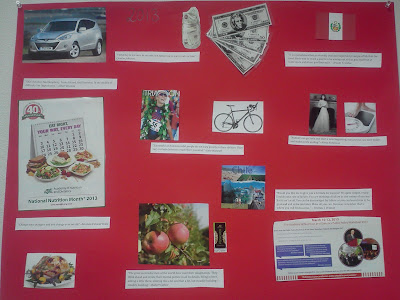 |
| Vision Boards can be a great way to help you visualize your goals |
We all do it, we make a resolution at New Year’s to do something and by January 3rd we are already neglecting it. Oftentimes by February 1st we forget that we even had a New Year’s resolution to begin with. Surveys show that most New Year's Eve Resolutions never become realized goals. Here are a few tips to stick to your resolutions and reach your goals in 2013.
1. Be sure to be specific as to what you want and make it something you can achieve. Many people will say “I want to lose weight” but few will say “I will to lose 15# by April when my daughter gets married.” Be sure to be specific whether it is so many pounds by a certain date or going to the gym/working out a minimum of 3 days per week. Create a vision board, buy a journal, write an “end of the year letter” or create a list of things you want to accomplish in the coming year. Use powerful statements such as "I am going to" or "I will" instead of "I want to."
2. Once you have decided on something specific, create a timeline for your goal and outline specific tasks and actions that you will need to take. Do you need to clean out the fridge on January 1st or pay that gym membership fee? Do it. Figure out what resources you will need and get them together before the first of the year if possible.
3. Start early. The biggest mistake people make in regards to New Year’s Resolutions is that they believe that they will magically wake up on January 1st and be motivated to achieve their goals. This is (unfortunately) not true as that day is just like today or any other day for that matter. Start on those resolutions THIS WEEKEND if you can.
4. Tell people about it! That’s right, when you tell others about the goals you want to accomplish you are more likely to stick to them. So post your vision board on a blog (like I did!) or post something on Facebook or Twitter or just tell a friend. If you feel like you need, ask them to keep you accountable to reaching your goal.
5. Track your progress. It is important that you track how well you are doing. Remember that falling off of the wagon today does not undo any previous progress made. Getting off track is normal but keeping track on a regular basis helps you get back on task. Do this with a daily journal or a weekly check-in note. There are many Smartphone applications (such as Mint.com for money, Noon Coach for weight loss and Evernote for keeping notes) to help you. Look at how far you have come to see how far you can go!






